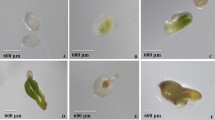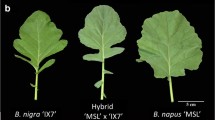Summary
Tartary buckwheat (Fagopyrum tataricum) was successfully hybridized with common buckwheat (F. esculentum), both diploid (2n=16), using the latter as male parent during bud pollination. The barrier normally encountered in such hybridization was overcome by enhancing the cross-compatibility of the two species, which was accomplished by synthesizing a unique genotype of common buckwheat. This novel plant was produced by selecting common buckwheat plants that exhibited, at isozyme loci PGM, SKDH and ADH, alleles with similar mobility to those found in tartary and then transferring these alleles to a single plant through six generations of breeding. Ovule culture was used to rescue the 7–10 day old embryos. On the rescue-culture medium 41% of the hybrid embryos formed calli larger than 200 μm in diameter. Most ceased to grow before reaching 1500 μm, but four out of 263 cultured ovules continued to grow as callus. One of these differentiated and formed callus with buds and shoots from which cloned plants were produced. The remaining embryos either did not grow at all or formed very small calli. When tartary was crossed with the original genotype of common buckwheat, only 22% of the hybrid embryos formed small calli and none differentiated. Hybridity of the calli and the plantlets was determined by RAPD and isozyme analysis, respectively. Flowers produced by the hybrid plants were of the same type (homomorphic) and size as those of tartary, but with white sepals like common buckwheat.
Similar content being viewed by others
Abbreviations
- CTAB:
-
cetyltrimethylammonium bromide
- GA3 :
-
gibberellic acid
- IAA:
-
indoleacetic acid
- IBA:
-
indolebutyric acid
- PVP:
-
polyvinylpyrrolidone
References
Adachi, T., 1986. Is it possible to overcome the low yield of buckwheat by means of biotechnology? Proc 3rd Int Symp Buckwheat, Pulawy, Poland, pp. 108–116.
Adachi, T., A.Yamaguchi, Y.Miike & F.Hoffman, 1989. Plant regeneration from protoplasts of common buckwheat (Fagopyrum esculentum). Plant Cell Reports 8: 247–250.
Baniya, B.K., K.W. Riley, D.M.S. Dongol & K.K. Sherchan, 1992. Characterization and evaluation of Nepalese buckwheat (Fagopyrum ssp.) landraces. Proc 5th Int Symp Buckwheat, pp. 64–74.
Boodley, J. . & R. Sheldrake Jr., 1977. Cornell Peat-Lite mixes for commercial plant growing. Cornell Univ Plant Sci Info Bull 43.
Cardy, B.J., C.W.Stuber & M.M.Goodman, 1980. Techniques for starch gel electrophoresis of enzymes from maize (Zea mays L.). Dept of Statistics Mimeo Ser no 1317, North Carolina State Univ, Raleigh.
Cheng, C. & R. Ni, 1992. Preliminary study on the addition of buckwheat flour and reserve of nutrient elements in buckwheat health food. Proc 5th Int Symp Buckwheat, pp. 480–483.
Chetelat, R.T., C.M.Rick & J.W.DeVerna, 1989. Isozyme analysis, chromosome pairing, and fertility of Lycopersicon esculentum x Solanum lycopersicoides diploid backcross hybrids. Genome 32: 783–790.
Choi, M.G., E.T. Koh & J.S. Ju, 1988. Comparison of repeated feeding of buckwheat, soybean, and brown rice meal responses in non-insulin dependent diabetic subjects (NIDDS). Fed Amer Soc Exp Biol 2 (5): abstract 3080.
DeJong, H., 1972. Buckwheat. Field Crop Abstracts 25 (3): 389–396.
Elagin, I.N., 1977. Role of bees in increasing yield and improvement seed germination and crop qualities of hybrid buckwheat seed. In: R.B. Kozin (Ed.), Pollination of Entomophilous Agricultural Crops by Bees, pp. 31–36.
Guan, L.M. & T.Adachi, 1992. Reproductive deterioration in buckwheat (Fagopyrum esculentum) under summer conditions. Plant Breeding 109: 304–312.
Gubbels, G.H., 1978. Yield, seed weight, hull percentage, and testa color of buckwheat at two soil moisture regimes. Can J Plant Sci 58: 881–883.
Hart, G.E., A.K.M.R.Islam & K.W.Shepherd, 1980. Use of isozymes as chromosome markers in the isolation and characterization of wheat-barley chromosome addition lines. Genet Res 36: 311–325.
Hayashi, H., 1992. Buckwheat production in a mountainous area of the central part of Japan. Proc 5th Int Symp Buckwheat, pp. 36–40.
Hogenboom, N.G., 1972. Breaking breeding barriers in Lycopersicon. 5. The inheritance of the unilateral incompatibility between L. peruvianum (L.) Mill. and L. esculentum Mill. and the genetics of its breakdown. Euphytica 21: 405–414.
Koh, E.T., M.K. Choi, J.S. Ju, C.S. Choi & Y.E. Park, 1988. Comparison of long-term effects of buckwheat, rice, and potato on glycemic indices in healthy subjects. Fed Amer Soc Exp Biol 2 (5): abstract 5259.
Kreft, I., 1983. Buckwheat breeding perspectives. Proc 2nd Int Symp Buckwheat, pp. 3–12.
Lachman, S., 1991. Plant cell and tissue culture in buckwheat: an approach towards genetic improvements by means of unconventional breeding techniques. In: T. Adachi (Ed.), Proc Int Colloquium o on Overcoming Breeding Barriers by Means of Plant Biotechnology, pp. 145–154. Miyazaki, Japan.
Marshall, H.G., 1969. Description and culture of buckwheat. The Pennsylvania State University Bulletin 754.
Marshall, H.G. & Y.Pomeranz, 1982. Buckwheat: description, breeding, production, and utilization. Adv Cereal Sci Tech 5: 157–210.
Morris, M.R., 1952. Cytogenetic studies on buckwheat. J Heredity 42: 85–89.
Murashige, Y. & F.Skoog, 1962. A revised medium for rapid growth and bioassay with tobacco tissue culture. Physiol Plant 15: 473–497.
Obendorf, R.L. & J. Slawinska, 1993. Seed set in buckwheat altered by temperature and water deficit stress (abstract). Agronomy Abstracts: 152.
Ohnishi, O., 1983. Isozyme variation in common buckwheat, Fagopyrum esculentum Moench, and its related species. Proc 2nd Int Symp Buckwheat, pp. 39–50.
Quisenberry, K., 1927. Chromosome number in buckwheat species. Bot Gaz 83: 85–89.
Rhodes, A.M., 1959. Species hybridization and interspecific gene transfer in the genus Cucurbita. Amer Soc Hort Sci 74: 546–551.
Ruszkowski, M., 1980. The possibility of changing the yielding of buckwheat by breeding the homostyle varieties. Symp on Buckwheat, Ljubljana, Yugoslavia, pp. 7–15.
Samimy, C., 1991. Barrier to interspecific crossing of Fagopyrum esculentum with Fagopyrum tataricum: I. Site of pollen-tube arrest. II. Organogenesis from immature embryos of F. tataricum. Euphytica 54: 215–219.
Snape, J.W., V.Chapman, J.Moss, C.E.Blanchard & T.E.Miller, 1979. The crossabilities of wheat varieties with Hordeum bulbosum. Heredity 42: (3): 291–298.
Stuber, C.W., J.F.Wendel, M.M.Goodman & J.S.C.Smith, 1988. Techniques and scoring procedures for starch gel electrophoresis of enzymes from maize (Zea mays L.). Tech Bull no 286, North Carolina State Univ, Raleigh.
Ujihara, A., Y.Nakamura & M.Minami, 1990. Interspecific hybridization in genus Fagoprum-properties of hybrids (F. esculentum Moench x F. cymosum Meissner) through ovule culture. pp. 45–51. Gamma Field Symp No 29, Inst Radiation Breeding, NIAR, MAFF, Japan.
Weeden, N.F., 1984. Distinguishing among white seeded bean cultivars by means of allozyme genotypes. Euphytica 33: 199–208.
Weeden, N.F. & R.C.Lamb, 1985. Identification of apple cultivars by isozyme phenotypes. J Amer Soc Hort Sci 110 (4): 509–515.
Weeden, N.F. & A.C.Emmo, 1985. Isozyme characterization of Kentucky bluegrass cultivars. Can J Plant Sci 65: 985–994.
Whitaker, T.W. & R.W. Robinson, 1986. Squash breeding. In: M.J. Bassett (Ed.), Breeding Vegetable Crops, pp. 209–240, AVI Publishing Co.
Williams, C.E. & D.A.StClair, 1989. Phenetic relationships and levels of variability detected by restriction fragment length polymorphism and random amplified polymorphic DNA analysis of cultivated and wild accessions of Lycopersicon esculentum. Genome 36: 619–630.
Williams, G.K., A.R.Kubelik, K.J.Livak, J.A.Rafalski & S.V.Tingey, 1990. DNA polymorphisms amplified by arbitrary primers are useful as genetic markers. Nucl Acids Res 18 (22): 6531–6535.
Young, N.D. & S.D.Tanksley, 1989. RFLP analysis of the size of chromosomal segments retained around the Tm-2 locus of tomato during backcross breeding. Theor Appl Genet 77: 353–359.
Zeven, A.C., D.R.Knott & R.Johnson, 1983. Investigation of linkage drag in near isogenic lines of wheat by testing for seedling reaction to races of stem rust, leaf rust and yellow rust. Euphytica 32: 319–327.
Author information
Authors and Affiliations
Rights and permissions
About this article
Cite this article
Samimy, C., Bjorkman, T., Siritunga, D. et al. Overcoming the barrier to interspecific hybridization of Fagopyrum esculentum with Fagopyrum tataricum . Euphytica 91, 323–330 (1996). https://doi.org/10.1007/BF00033094
Received:
Accepted:
Issue Date:
DOI: https://doi.org/10.1007/BF00033094




